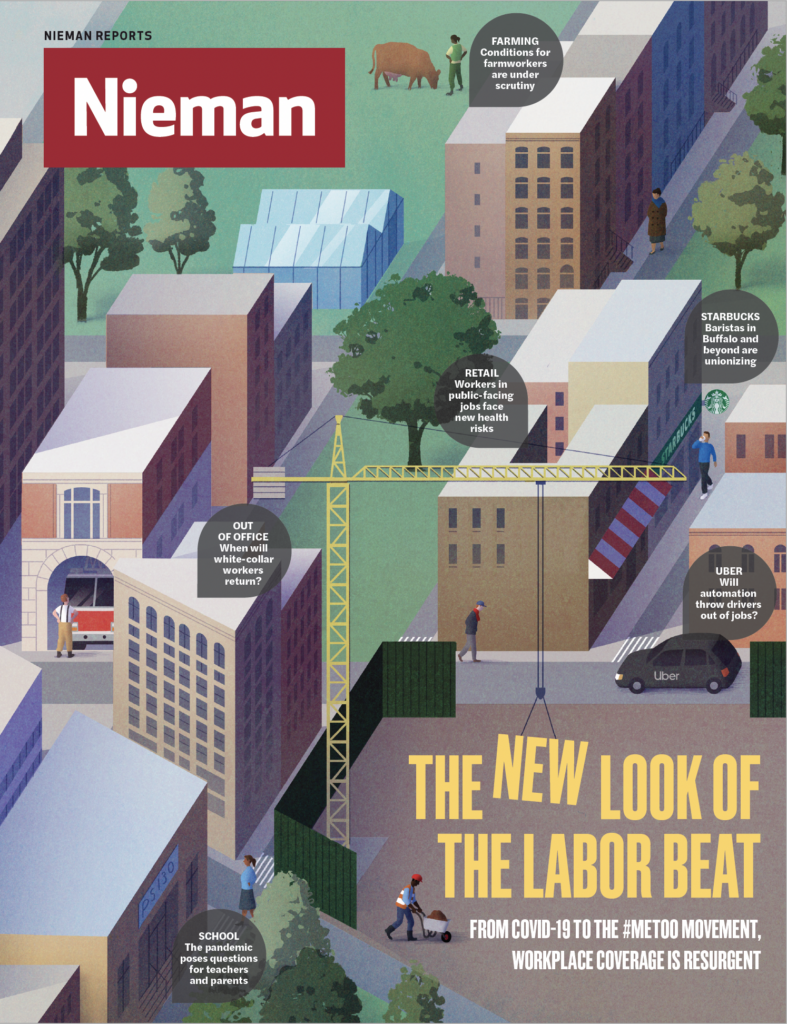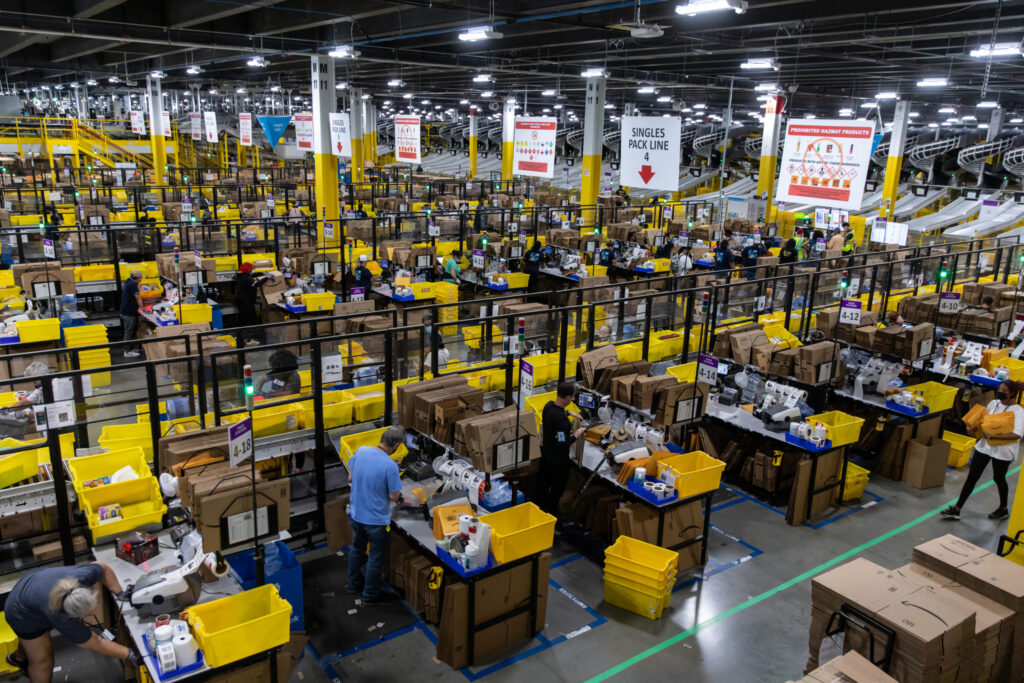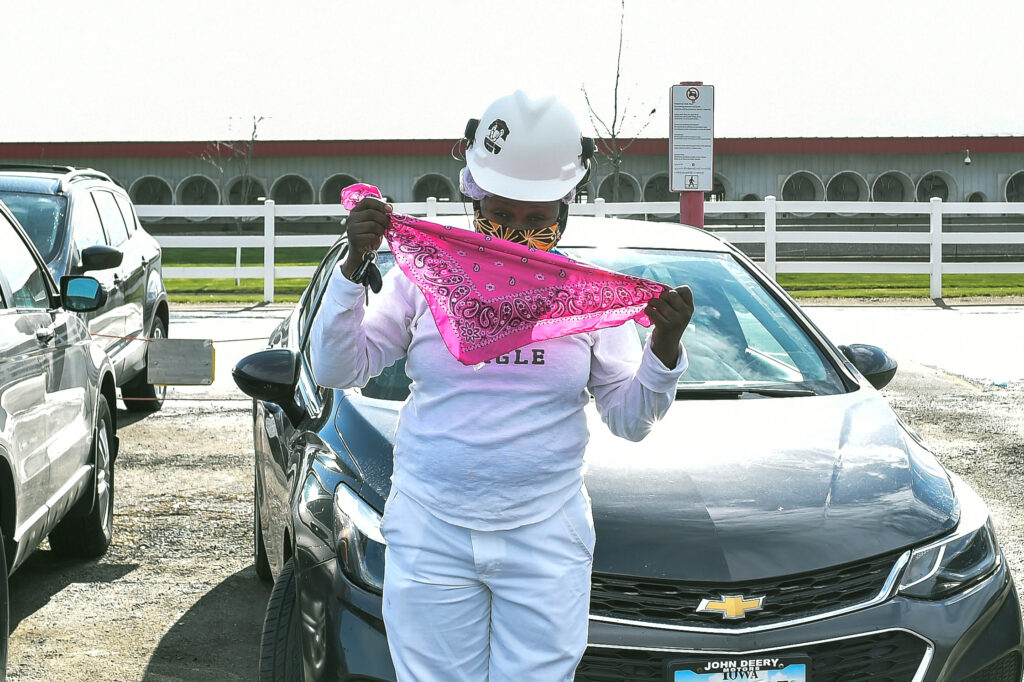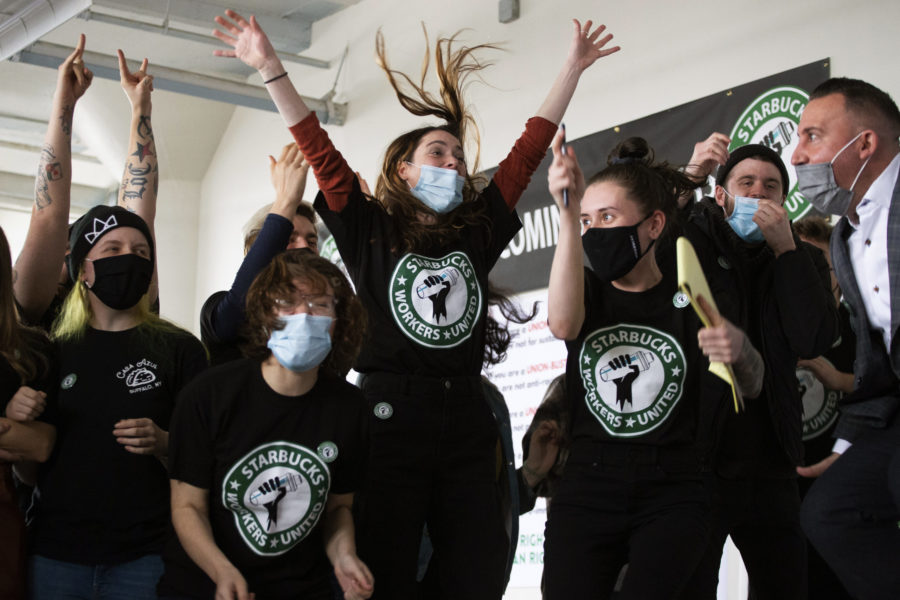
Once considered a marquee assignment, the labor beat spent years on the decline. Over the past decade, however, the beat has bounced back to cover everything from how Uber treats its workers to the #MeToo movement to the lack of affordable child care.
Fueled by the Great Recession, the rise of digital media, and the pandemic, today’s labor beat tackles a different set of questions from its union-centric predecessor: Will many white-collar workers never return to the office? Will pandemic-battered workers press for workplace safety? And will the Great Resignation cause American corporations to treat their workers far better?
In her six years as a reporter at The Courier in Waterloo, Iowa, Amie Rivers has mainly covered politics and local news. In the weeks before the pandemic hit in March 2020, she wrote stories about a real estate agent announcing plans to run for an Iowa House seat and about the police arresting a man who was found asleep at the wheel at a red light.
But soon after Covid-19 hit, Rivers focused on an outbreak at Tyson’s huge pork-processing plant in town. First, she wrote about workers’ suspicions that there was a Covid outbreak, and she soon followed that with larger stories about how Tyson’s crowded working conditions had let the virus rip through the plant’s 2,800 workers. The national media jumped on the story that Rivers broke, and in May, about 1,000 of the plant’s workers tested positive.
“We started getting these tips from people,” Rivers said. “They were really worried about getting sick, and they didn’t think their employer was doing anything about it. Right away that set off alarm bells.”
Recognizing that the Covid outbreak at Tyson was an important labor story, Rivers and her editors jumped on it even though their paper covered labor issues only infrequently before the pandemic. After years of cutbacks, only a handful of reporters remained at the Courier, and as with many financially battered newsrooms, labor coverage was an early casualty of the paper’s downsizing. The labor beat, which in the decades after World War II was considered a marquee assignment, began to fade away along with the power and prominence of the unions being covered.
Related Reading
Newsrooms Are Unionizing Pretty Much “Nonstop.” Here’s Why
By Steven Greenhouse
Why Newsrooms Are Unionizing Now
By Steven Greenhouse
But in the last dozen years, there has been a resurgence of the labor beat, largely fueled by two developments: the Great Recession, which saw the jobless rate jump to 10 percent, and the rise of digital media, which often tilts to the left and has many readers who are interested in how American workers are treated — or mistreated. In 2020, as the pandemic took hold, labor stories became many of the nation’s biggest news stories: the millions of workers laid off when businesses shuttered temporarily, the risks facing grocery and transit workers, the dangers facing health care workers, the abuse flight attendants receive from passengers refusing to wear masks, the work-from-home revolution, the many frightened teachers who wanted their schools closed. More recently, other pandemic-related labor stories have leapt onto the front page, including the debate over vaccine mandates for workers, the labor shortage in many industries, and the record number of Americans quitting their jobs in what has been called the Great Resignation. “The pandemic has really been a galvanizing event in terms of labor coverage,” said Christopher Martin, a professor of digital journalism at the University of Northern Iowa.

With the flood of workplace stories in this unprecedented moment, it seems likely that labor coverage will remain strong and perhaps even grow. In decades past, labor reporters usually focused on covering labor unions, their strikes, and contract negotiations. Today, the beat has expanded to include everything from how Uber treats its drivers to some Amazon workers not having enough time to go to the bathroom to issues like the #MeToo movement, work-family balance, and the lack of childcare. During the pandemic, traditional concepts of office work have been radically altered and the relationships between employers and employees have changed, as well. All this is raising broader questions that journalists will need to cover: Will many white-collar workers never return to the office? Will the labor shortages accelerate the introduction of new automation? Will pandemic-battered workers increasingly seek to unionize, as we’ve seen at Starbucks and Amazon? Will the Great Resignation cause American corporations to treat their workers far better?
In newspapers across the United States, the labor beat once had a major presence, whether it was covering the Flint sit-down Strike in the 1930s, corruption in the Teamsters in the 1950s, the rise of Cesar Chavez and the United Farm Workers in the 1960s, or Ronald Reagan crushing the air traffic controllers’ strike in 1981. The beat solidified during the 1930s and the Great Depression, when there was an explosion of strikes and workplace protests and landmark New Deal legislation was enacted, leading to a burst of unionization at auto plants, steel mills, coal mines, and many other worksites.
Louis Stark, who was The New York Times’ labor beat reporter at the time, became a model with his in-depth articles about sit-down strikes, new labor legislation, and fierce union battles in Harlan County, Kentucky. In 1942, Stark won a Pulitzer Prize for his “distinguished reporting of important labor stories.” In the late 1940s and early 1950s, there was tremendous labor turmoil, with more than 400 large strikes some years. At times, labor was the nation’s dominant story, whether it was a nationwide rail strike, a coal miners’ walkout, or President Truman seeking to seize the nation’s steel mills in 1952. Many days, newspapers ran several labor stories on their front page. I remember counting seven labor stories on a New York Times front page from the late 1940s.
But the labor beat began a steep decline late last century. Starting in the 1970s, as newspaper chains acquired family-owned papers, and as many executives with MBAs moved into the publisher’s suite, newspapers increasingly targeted affluent, college-educated, and suburban readers (whom advertisers wanted to reach). At the same time, they cut back coverage that targeted working-class readers. As a result, Martin has written, there were fewer stories about labor and more stories about food, travel, lifestyle, and how to invest — stories geared to upscale readers. In his book, “No Longer Newsworthy: How the Mainstream Media Abandoned the Working Class,” Martin notes that many newspaper executives opted to focus on “quality demographics” rather than mass circulation.
After several decades of decline, the labor beat began a slow rebound about a decade ago — a rebound that continues to this day
Another reason for the decline in labor coverage was that the percentage of workers in unions slid from 35 percent in the mid 1950s to about 10 percent today. Moreover, factory jobs — which were long organized labor’s base — went from representing more than 3 in 10 non-farm jobs to less than 1 in 10 today, a slide caused by factory automation, manufacturing moving overseas, and many plants closing due to competition from imports. Paralleling this decline in factory jobs was a sharp decline in the number of strikes, and that, too, contributed to a decrease in labor coverage.
As factory jobs declined, there was a boom in service-sector jobs — in fast-food, retail, hotels, and other sectors — and those jobs, which were often low-wage jobs, became more important to the economy and to the news. “Sometime in the 1990s you began to get labor coverage not about union workers, but about what’s going on at McDonald’s, what’s going on at Walmart,” says Nelson Lichtenstein, a long-time labor history professor at the University of California, Santa Barbara.
As newsrooms downsized and searched for new audiences, the labor beat — long viewed as unsexy — was often one of the first to go. Seeing their positions disappear, some labor beat reporters complained that their news organizations were focusing increasingly on celebrity news and gossip to get clicks. Many newspapers, Martin notes, moved their labor coverage into the business section and reshaped the beat to focus on subjects like job training and how to maintain employee morale. The coverage became less about how labor unions could help workers through collective action and more about how individuals could elevate their career — stories, for instance, about how to ask for a raise or a promotion or about finding time to get an MBA. When it came to labor developments, business editors often wanted reporters to focus on how they affected companies and their share prices, says Stephen Franklin, who used to write about labor for the Detroit Free Press and the Chicago Tribune. “They weren’t very interested in workers,” he says, noting that some business editors had a hostile attitude toward unions.
By 2010 or so, the labor beat had fallen to a low point: The Washington Post, The Wall Street Journal, the Los Angeles Times, the Chicago Tribune, and many other daily newspapers no longer had full-time labor beat reporters. (For a while, I, at The New York Times, was the only full-time daily labor beat reporter left.)
After several decades of decline, the labor beat began a slow rebound about a decade ago — a rebound that continues to this day. As the Great Recession unfolded, many editors recognized that the predicament faced by millions of jobless workers was an important story. Without labor beat reporters, editors often turned to economics or general assignment reporters to cover the plight of the unemployed.
Around the same time, a group of digital-native publications began covering the beat. In 2011, HuffPost asked Dave Jamieson to be its full-time labor reporter. Not long after, Vice, Vox, and BuzzFeed added labor reporters. These new digital reporters deepened the nation’s labor coverage, writing, for instance, about Uber Eats delivery workers often not receiving the tips that customers gave and why women are underrepresented in Silicon Valley engineering jobs. Victor Narro, a professor of labor studies at UCLA, says, “The emergence of labor coverage in digital media has pushed the likes of the L.A. Times and other publications to reinvest in labor coverage, which had not been a priority.”

For the past decade, Jamieson has written roughly 150 labor stories a year, covering everything from the John Deere and teachers’ strikes, to maskless shoppers endangering retail workers during the pandemic, to postal workers dying from heat stroke in 110-degree weather. The beat was busy before the pandemic, but since March 2020, the focus on workers and workplace safety has intensified.
“In the pandemic, workplace safety became an A-1 story all over the place,” Jamieson says. “It was the biggest workplace safety crisis we’ve had in decades.”
Concerned about the pandemic’s effects on “essential” workers, Jennifer Gonnerman, a writer for The New Yorker who usually covers criminal justice and urban affairs, decided to do an in-depth profile of a New York City bus driver and the perils he faced. More than 100 New York transit workers have died from Covid. “The class divide in the country became crystal clear,” says Gonnerman. “Wealthy people left the city, and white-collar workers were working from home and Zooming in. Essential workers — bus drivers, nurses, delivery workers, and thousands of others — kept the city going. I felt we really needed to understand their lives.” She profiled Terence Layne, a 55-year-old bus driver whose father died of Covid-19. Her profile won a National Magazine Award.
“When the pandemic hit, everybody became a labor and workplace reporter,” says Noam Scheiber, The New York Times’ labor workplace reporter. “If you covered Google or Amazon or Uber or retail or the subways or public sector workers, you became a labor reporter.” Retail reporters like Michael Corkery at The Times, Abha Bhattarai at The Washington Post, and Nathaniel Meyersohn at CNN Business all wrote repeatedly on Covid-19’s impact on workers. There were stories about retailers refusing to require customers to wear masks even though that could endanger their employees and about CEO’s getting large payouts while their companies did not give hazard pay to the essential workers who showed up day after day to serve customers.
When the pandemic hit, everybody became a labor and workplace reporter
The pandemic laid bare the harsh reality faced by millions of low-wage workers. Many need more than one job just to afford basic necessities, often lack paid sick days to care for themselves or family members, and typically struggle to find affordable childcare — topics the media has covered with heightened urgency during the pandemic. “One of the striking things about the coronavirus,” says Josh Eidelson, the labor reporter for Bloomberg News and Bloomberg Businessweek, “is how it touched every sort of workplace, in unequal ways and with unequal consequences.” Eidelson’s pandemic stories have included the problems with employer gag rules that prohibit workers from telling their coworkers that they contracted Covid-19 and how the nation’s fractured unemployment insurance system failed millions of workers laid off during the pandemic.
Another issue reporters are grappling with is, what does it mean that white-collar workers are transitioning away from the traditional office and working remotely in far greater numbers than ever before? Thousands of office workers have moved to scenic locales hundreds of miles from their downtown offices, and many will resent orders to return to the office. Meanwhile, as Washington Post labor reporter Eli Rosenberg writes, even as workers at some companies return to the office, office life might never be the same. Workers describe a strange, changed office environment — “a world of complicated social interactions, lingering anxieties about masks and vaccinations, and simmering frustrations about inflexible work policies.”
In recent months, the pandemic-inspired boom in labor coverage has grown even bigger for two reasons. First, there has been a surge of strikes and threats to strike at John Deere, Kellogg’s, Nabisco, Kaiser Permanente, and numerous other companies as many workers, after facing considerable risks at their jobs during the pandemic, felt frustrated, unappreciated, and even angry that their employers were not being far more generous in contract negotiations. Second, record numbers of workers have been quitting their jobs in what economists are calling “the Great Resignation.” Labor reporters, economics reporters, and others have rushed to cover this phenomenon: Why are so many workers quitting and what does it mean for the economy, employers, and the nation’s supply chain? There are many reasons to explain why more than 4 million workers have been quitting their jobs each month recently, among them a lack of affordable childcare, but the biggest reason is that the labor shortage in some industries has given millions of workers a welcome opportunity to jump to jobs that pay them more and treat them better.

For labor beat reporters of yesteryear, their agenda was largely set by labor unions: a strike threat against United States Steel or making increased pensions their main contract demand. But today, the agenda is broader and usually set by the reporter, often with a focus on income inequality and injustice. That can mean stories about the pay gap for women, higher unemployment rates for African Americans, the higher fatality rate for Hispanic construction workers, and how a lack of childcare keeps women out of the workforce.
“I’ve always seen the beat not so much as union-focused, but one encompassing economic justice and workplace conditions — and about relations between employers and workers,” says Margot Roosevelt, an L.A. Times economics and labor reporter. “The issues around inequality are of tremendous interest to our editors up and down the masthead. Any focus on those issues is central to understanding what’s happening in this country today, not just economically, but socially and politically.” As a nod to that reality, some labor reporters have renamed their beat, “labor and workplace reporter.”
Long before the pandemic, the beat was expanding to include many non-union stories like how to deal with bullying bosses, the problems college graduates face finding jobs, farmworkers toiling in 100-degree heat, why Amazon has such a high employee turnover rate, and whether the advent of self-driving cars will throw many Uber and Lyft drivers out of jobs. The labor beat also now includes covering racial discrimination and sexual harassment. #MeToo stories are an undeniable type of labor coverage: They’re largely about men harassing or abusing women who work for them — or, as with Harvey Weinstein, women who wanted to be hired by them.
Labor stories can take many forms. Juliana Feliciano Reyes did an unusual labor story for The Philadelphia Inquirer that went viral: Why Philadelphia men list their union membership on Tinder. One of the answers, Reyes explained, was they think the good pay and benefits that union workers get will attract potential partners. When Reyes started in the role, the beat and title was “the culture of the workplace,” but over time her coverage reverted to more traditional labor stories.
With an eye to wooing young readers, some editors see a definite upside to workplace coverage. Many young Americans have been inspired by Bernie Sanders and the Fight for $15, have had problems in the job market, and are unionizing, whether they are grad students, museum workers, digital journalists, or more recently, Starbucks baristas. Indeed, a recent Gallup poll found that 77 percent of Americans between 18 and 34 approve of unions, as do 68 percent of all American adults — the highest level in decades.
Many major newspapers and many digital news organizations now have reporters dedicated to the beat. Last April, National Public Radio named Andrea Hsu as its “labor and workplace correspondent.” Beyond the mainstream media, there are reporters covering labor at many progressive and leftist publications, including In These Times, Jacobin, Dissent, the American Prospect, Labor Notes, The Progressive, Payday Report, Strikewave, and The Nation.
Lauren Kaori Gurley, a labor reporter at Vice’s Motherboard since 2019, has probably had more big scoops on the beat than anyone else over the past year. Her scoops include leaked audio of Amazon workers challenging and grilling managers who were attacking unions at an Amazon anti-union meeting and McDonald’s having a secretive intelligence team that spied on workers active in the Fight for $15.
“It’s gotten more competitive,” Gurley says. “There’s a competition for publishing stories first.” There’s also competition to get the highest impact stories. After Amazon denied allegations that its delivery drivers ever peed into bottles, Gurley posted a story about Amazon drivers who did just that. Several drivers used social media to send her photos of their urine-filled bottles and told Gurley that they had to deliver so many Amazon packages each day that they often didn’t have time to find bathrooms. Her story went viral and badly embarrassed Amazon.
“The issues around inequality are of tremendous interest to our editors up and down the masthead. Any focus on those issues is central to understanding what’s happening in this country today, not just economically, but socially and politically.”
– Margot Roosevelt, L.A. Times
As the beat has shifted to focus more on income inequity and power imbalances, some reporters — for instance, Jonah Furman, a writer for Labor Notes — acknowledge that they consider themselves activists as well as journalists. Seeing how powerful and wealthy corporations are and seeing the nation’s immense income inequality, they want not just to write about workers, but to advance their cause. Furman says that his definition of labor journalist “doesn’t fit The New York Times version of labor journalist.” For example, in an article he co-wrote about a threatened strike at Kaiser Permanente, the giant health care provider, he called Kaiser’s offer of a 1 percent raise “piddling” and its arguments for a two-tier pay structure “bogus.” Beyond his writing duties, Furman helps organize workshops that teach labor activists how to be more effective.
While most other labor journalists don’t consider themselves activists, they often admit to being sympathetic to workers on workplace issues. One trend that is making journalists better understand the tumult workers face is what’s been happening to newspapers across the nation: corporate acquisitions and newsroom downsizing. The Courier in Waterloo went from an editorial staff of around two dozen to just five; HuffPost’s bargaining unit from around 250 to about 80. “It helps you understand the turbulence that many workers are facing,” Jamieson says.
Sarah Jaffe, a leading labor journalist, remembers that when she was just out of graduate school 12 years ago, it was hard to get assignments to do labor stories, even from publications on the left. But, she says, it became considerably easier to get such assignments thanks to three tumultuous developments: the colossal battle in Wisconsin in 2011 over then-Gov. Scott Walker’s push to hobble public-sector unions, the Chicago teachers’ strike of 2012, and the birth of the Fight for $15, which held its first strikes in 2012. “Each one of those made it easier to explain to people why we should care about this organizing drive or this strike or these questions involving workers,” Jaffe says. Now, she often writes for The Progressive and The Nation and co-hosts a podcast, “Belabored,” which is presented by Dissent magazine.
Despite the increased number of journalists on the beat, some labor reporters say there still aren’t enough people covering the topic, especially in places that aren’t New York City or Washington, D.C. “There’s … a lot of coverage still lacking all over the place,” says Jamieson. “There’s a lot less than there was in small and midsized papers.” Jaffe agrees, noting that many labor freelancers can’t find full-time writing jobs. “We need 300 more labor journalists, but there aren’t jobs for them.”
For now, social media is helping to fill the gap. Through Twitter especially, reporters can deliver or receive minute-to-minute updates on strikes and other protests across the country. Through a steady stream of tweets as well as some on-the-scene articles, Kim Kelly, who writes a freelance labor column for Teen Vogue, has gotten many journalists far outside of Alabama to pay attention to the strike by more than 1,000 Warrior Met Coal miners that began April 1.
Edward Ongweso Jr. frequently finds himself writing stories about labor even though he is a tech industry reporter at Vice’s Motherboard. Ongweso says lots of important labor stories pop up at tech companies, whether at Amazon, Uber, Google, or video game companies. “Sometimes it’s ‘let’s surveil every worker,’” he says. “Sometimes it’s ‘let’s snuff out any dissent.’ Sometimes it’s ‘let’s develop some really repressive union-busting techniques.’ There’s so much to write about labor.”
Martin, the professor at the University of Northern Iowa, is delighted to see the revival, however incomplete, of the labor beat. “It’s good for connecting with a potentially very big audience, an audience I’ve argued that has been forsaken for many decades,” he says. But he fears that when the pandemic ends and the “Great Resignation” is just a memory, labor coverage will once again recede. In his view, that would be bad for the nation and its future, undermining our ability to understand what’s happening with America’s economy and its 155 million workers.



